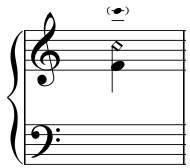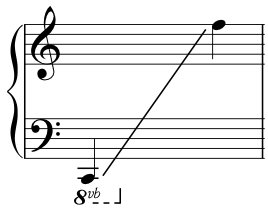Fifth Harmonics
Third partial harmonics are generally called fifth harmonics among harpists, referring to the resulting sound of one octave and a fifth above the fundamental.
Production
The string is stopped with the knuckle or the side of the hand at a point that is exactly 2/3 of the string's total length away from the soundboard. The thumb plays the upper 1/3 of the string. As the thumb plays the string, the knuckle or the base of the hand leaves the string, letting it resonate.
Sound
Fifth harmonics are somewhat softer than octave harmonics, but they are still clear and reliable. The pitch follows the natural overtone series and is therefore 2 cents higher than the same note in equal temperament.
Notation
Fifth harmonics are notated with a little diamond placed a fifth above the played note. The resulting note sounds an octave and a fifth higher. To avoid confusion, it is helpful in this case to write the sounding pitch in parentheses above the note the first time such a harmonic occurs.

Fifth harmonic.
Range
Fifth harmonics can be produced in the following range:

Range for fifth harmonics.
N.B. Harmonics in the lowest octave of the harp sound soft and rather undefined.